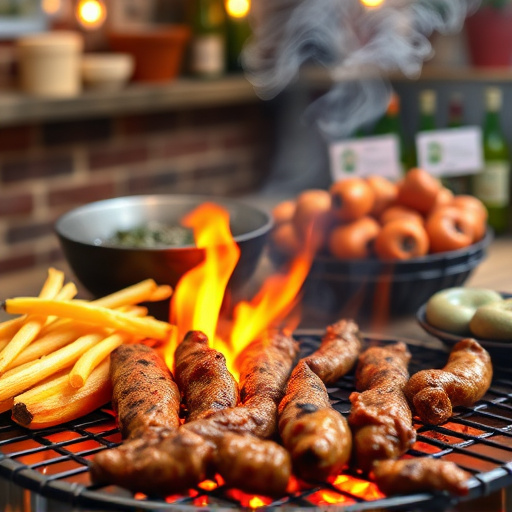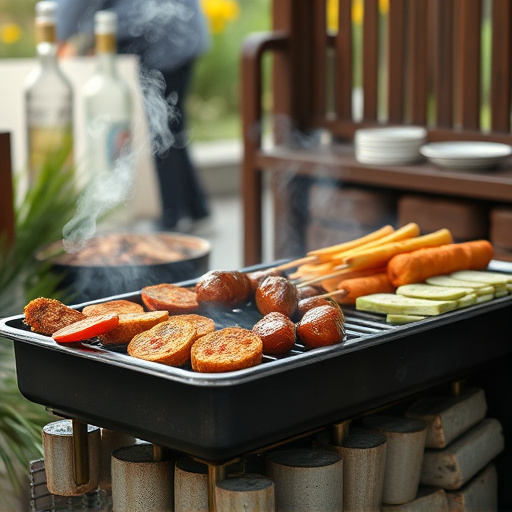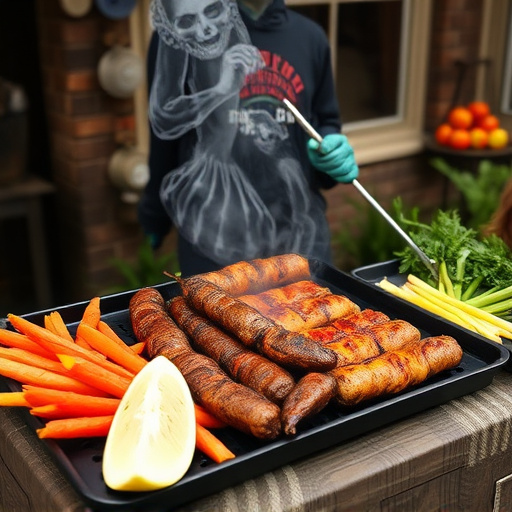Selecting the right cut, crafting a killer dry rub, mastering smoking techniques, and proper slicing ensure a mouthwatering Smoked BBQ Brisket Recipe that impresses guests. Use whole packer brisket, trim fat wisely, experiment with spices, maintain low temperatures, and rest meat post-smoking for optimal results (165°F – 170°F or 74°C – 77°C). Serve on a large platter with garnishes and classic sides.
Unleash your inner BBQ master and impress your guests with a succulent, perfectly smoked brisket. This comprehensive guide takes you through every step of crafting the ultimate smoked BBQ brisket recipe. From choosing the ideal cut to mastering seasoning and cooking techniques, we’ll equip you with the knowledge to achieve tender, flavorful meat that’s sure to be the talk of your next gathering.
- Choosing the Perfect Brisket Cut: A Guide for Optimal Flavor
- Seasoning 101: Crafting a Killer Dry Rub
- Mastering the Smoke: Techniques for Consistent Results
- Slow and Steady Win the Race: Cooking Times and Tips
- The Art of Slicing and Serving: Presenting Your Succulent Brisket
Choosing the Perfect Brisket Cut: A Guide for Optimal Flavor

When it comes to crafting a mouthwatering smoked BBQ brisket recipe, selecting the right cut is half the battle won. The brisket, a muscle with immense potential, offers various options, each with its unique characteristics and ideal preparation methods. Look for a whole packer brisket, which is the most popular choice among barbecue enthusiasts. This cut features both the point (fatty end) and flat (leaner portion), allowing for a balanced flavor profile during smoking.
For optimal results in your smoked BBQ brisket recipe, consider asking your butcher to trim away excess fat, leaving a thin layer to keep moisture in. This moderation ensures that the brisket doesn’t become overly greasy while still imparting rich, savory flavors. Aim for a target internal temperature of 165°F to 170°F (74°C to 77°C) to ensure it’s tender and juicy when sliced.
Seasoning 101: Crafting a Killer Dry Rub

Crafting the perfect dry rub is key to achieving a mouthwatering smoked BBQ brisket recipe that will impress your guests. A well-seasoned rub enhances the natural flavors of the meat, adding depth and complexity with every bite. Start by combining coarse sea salt and pepper, as these are essential for drawing out juices and adding a savory kick. Next, incorporate spices like paprika, garlic powder, and onion powder to bring a smoky, sweet, and slightly spicy profile. Don’t overlook the power of mustard seed, which adds heat and moisture, or brown sugar for a sticky, caramelized crust. Adjusting the ratios based on your preference will result in a rub that’s tailored to your taste.
Experiment with additional spices like cayenne pepper, chili powder, or even dried herbs like thyme and rosemary for unique variations. Remember, the key is balance—too much heat can overpower, while too little might not make an impact. Test small batches on samples of brisket before applying it to your main cut, ensuring you achieve the desired flavor profile. With practice, you’ll develop a killer dry rub that will transform your smoked BBQ brisket into a showstopper at any gathering.
Mastering the Smoke: Techniques for Consistent Results

Mastering the art of smoking is key to creating a mouthwatering smoked BBQ brisket recipe that will have your guests licking their bones. The process involves more than just lighting a fire; it’s about understanding wood types, temperature control, and the delicate balance between time and moisture. Choose hardwoods like oak or hickory for a robust flavor, and maintain a consistent low temperature—ideally between 225°F to 250°F (107°C to 121°C)—to ensure even cooking. This slow and steady approach allows the brisket to absorb smoke flavors without overcooking or drying out the meat.
For consistent results, use a combination of direct and indirect heat, depending on your preferred level of smoke penetration. A two-zone oven—one side hot, one side mild—is an excellent setup for precise control. Brush the brisket with a thin layer of barbecue sauce halfway through cooking to add sweetness and moisture, but avoid excessive glazing to prevent caramelization issues later. The key is patience; allow the brisket to rest for at least an hour after smoking to ensure those tantalizing flavors set in before slicing and serving to your eager guests.
Slow and Steady Win the Race: Cooking Times and Tips

When it comes to crafting the perfect smoked BBQ brisket recipe, understanding that slow and steady cooking wins the race is key. The art of smoking meat takes time—often several hours—to achieve that mouthwatering, tender, and juicy result. Patience is a virtue in this process, as rushing can lead to dry, tough brisket.
For the best results, aim for low and slow cooking temperatures, typically between 225°F to 250°F (107°C to 121°C). This gentle approach allows the collagen in the meat to slowly break down, ensuring a tender texture. Regularly checking the temperature and adding wood chips or chunks for smoke infusion will help maintain consistent heat and flavor throughout the cooking process.
The Art of Slicing and Serving: Presenting Your Succulent Brisket

When it comes to presenting your smoked BBQ brisket recipe, proper slicing and serving techniques can elevate your dish from ordinary to extraordinary. The art of slicing ensures each bite is tender, flavorful, and visually appealing. Start by removing the brisket from the smoking area or oven when it reaches the desired temperature—typically around 203°F (95°C). Allow it to rest for about 30 minutes, which helps in achieving a juicy interior and crisp exterior.
Use a sharp knife or a meat slicer to cut the brisket against the grain, resulting in thin, even slices. This technique prevents tough, chewy textures. Serve the sliced brisket on a large platter, garnished with your favorite BBQ sauce, fresh herbs, or a drizzle of creamy horseradish. Accompany it with sides like coleslaw, baked beans, and cornbread for a classic BBQ spread that will surely impress your guests.
